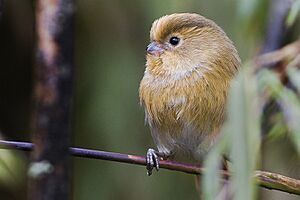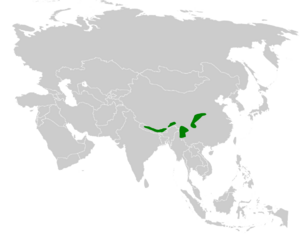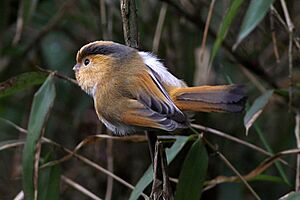Fulvous parrotbill facts for kids
Quick facts for kids Fulvous parrotbill |
|
|---|---|
 |
|
| Paradoxornis fulvifrons fulvifrons from Pangolakha WLS, Sikkim, India | |
| Conservation status | |
| Scientific classification | |
| Genus: |
Suthora
|
| Species: |
fulvifrons
|
 |
|
| Global distribution | |
| Synonyms | |
|
Paradoxornis fulvifrons |
|
The fulvous parrotbill (Suthora fulvifrons) is a small, unique bird. It belongs to a group of birds called parrotbills. People sometimes call it the fulvous-fronted parrotbill or fulvous-fronted crowtit.
This bird has four different types, called subspecies. Each type lives in a slightly different area. You can find them in places like central Nepal, Bhutan, India, China, and Myanmar.
Where It Lives
The fulvous parrotbill loves bamboo! It lives only in thick bamboo forests. These birds prefer to live high up in the mountains. They are usually found between 2,440 and 3,660 meters (about 8,000 to 12,000 feet) above sea level. Sometimes, they might be seen a bit lower, around 1,700 meters (about 5,500 feet). These birds do not migrate, meaning they stay in the same area all year.
What It Looks Like
The fulvous parrotbill is a small bird, only about 12 to 12.5 centimeters (around 5 inches) long. Its feathers are mostly a rich, warm orange-brown color. This color covers its head, the top of its wings, its sides, and its tail. Its belly is white.
A cool feature is the black stripe above its eye. This stripe gets wider in the middle and then thinner again. There's also a faint white stripe just below its eye. Male and female birds look very similar. Young birds look like the adults but have slightly darker feathers.
Different types of fulvous parrotbills have small differences in their looks. For example, one type has a paler belly. Another has a darker stripe above its eye. A third type has a blue-grey stripe above its eye and brighter feathers overall.
What It Eats
The fulvous parrotbill enjoys eating the buds of bamboo and birch trees. It also looks for tiny seeds and small insects. To help digest its food, this bird swallows small pieces of grit. These bits of grit act like tiny stones in its stomach, helping to grind up its food.
When it's not breeding season, these birds often gather in groups. You might see flocks of up to 20 or 30 fulvous parrotbills together.
Reproduction and Life Cycle
Fulvous parrotbills build their nests in the shape of a bowl. Both the mother and father bird work together to build the nest. They use bamboo leaves, small roots, and moss. These nests are hidden in dense bamboo patches. They are usually placed between 0.7 and 1.9 meters (about 2 to 6 feet) off the ground.
A female fulvous parrotbill usually lays about three eggs. The eggs are a pretty pale blue color. Both parents take turns sitting on the eggs to keep them warm. They also both help to care for the baby birds once they hatch. Sometimes, their nests are not successful. This might be because people disturb them.



